Book Chapter Summary Template | Easy & Effective Guide
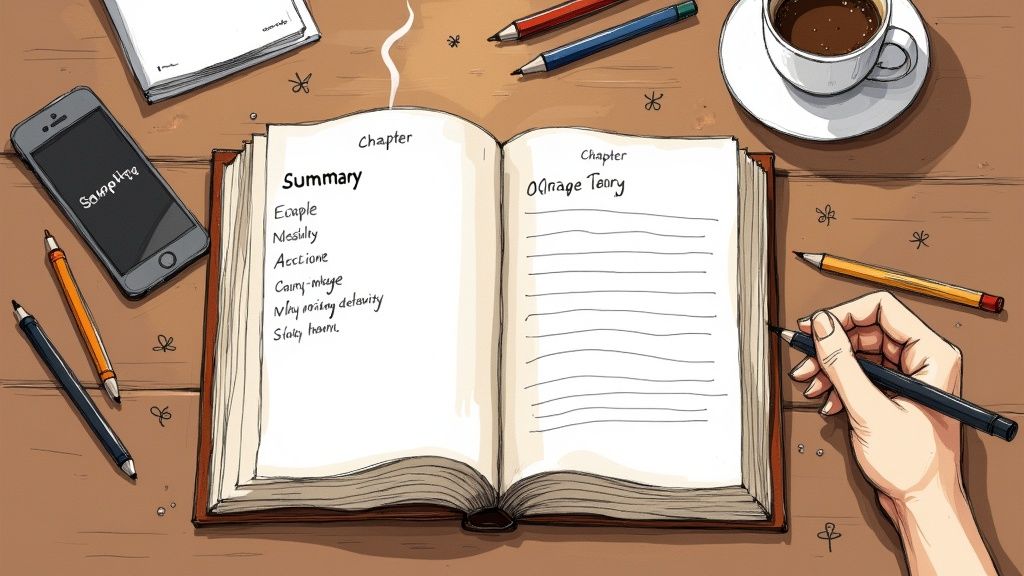
Why Your Current Note-Taking Isn't Working
Let’s be honest. You’ve probably spent hours bent over a textbook, your favorite highlighter turning whole pages into a fluorescent art project. You’ve scribbled frantic notes in the margins, sure that every single thought is a gem. But when it’s time to actually recall that information—for an exam, a report, or just to make a point—it’s like trying to find one specific needle in a haystack you built yourself. If this sounds painfully familiar, you're not alone. The issue isn't your effort; it’s your method.
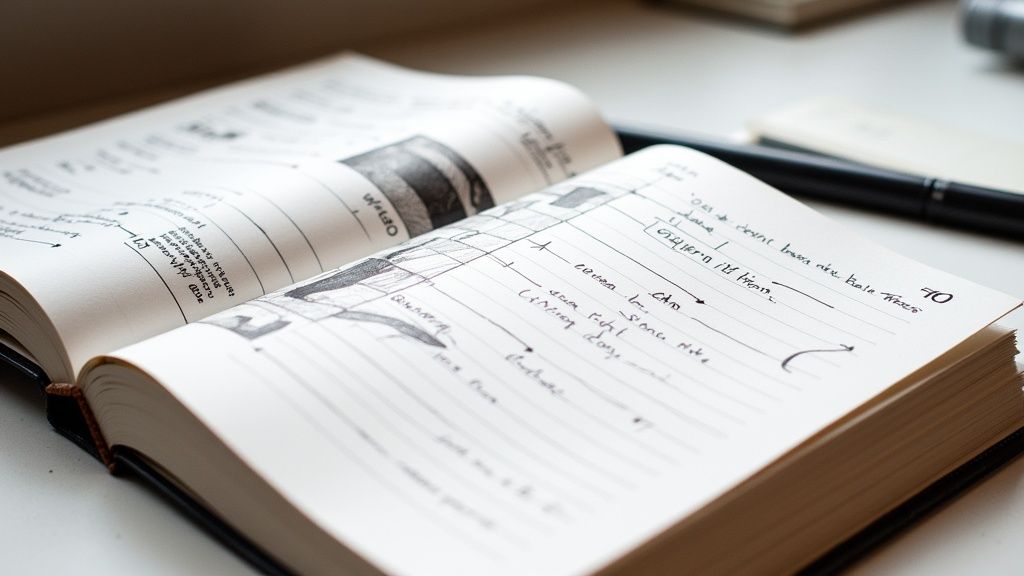
The Chaos of Unstructured Notes
Our brains need order and patterns to truly grasp new information. When you just highlight passages or jot down random thoughts as they come, you're practicing passive reading. You’re identifying what seems important in that moment, but you aren’t building the mental connections required for long-term memory. It’s like tossing ingredients into a bowl with no recipe—you have all the parts, but no clear way to make a finished meal.
Think of the typical student drowning in a sea of color-coded notes. Every color supposedly has a "system," but the final product is a visually noisy page with no clear information hierarchy. On the other side, you have the minimalist whose notes are so sparse they lack the context needed for real understanding. Both methods fail because they don’t have a guiding structure. This is exactly why a book chapter summary template is so powerful; it gives your brain the framework it needs to actively process, organize, and, most importantly, hold onto what you read. You might also be interested in our guide on creating a full blog series from your book, which applies similar principles of structured content.
From Passive Highlighting to Active Comprehension
Making the change from scattered notes to a structured template is all about moving from passive recognition to active recall and synthesis. A template forces you to ask specific questions: What’s the primary argument here? What are the key points supporting it? How does this chapter connect to what came before? This structured approach turns reading from a passive activity into an analytical one.
The value of this is clear, especially in educational settings. Surveys from educational platforms show that over 60% of both teachers and students find summary templates very helpful for organizing information from textbooks. By giving you designated spaces for themes, characters, key terms, and personal reflections, a template does more than just hold information—it actively guides your thinking process. It ensures you’re not just skimming words but are building a solid mental model of the chapter’s content, making it much easier to recall later. You can see how educators and students are using templates for better organization on Notion.com to achieve this.
What Makes Templates Actually Work
Ever downloaded a template, full of promise, only to have it sit unused in a folder, gathering digital dust? We’ve all been there. The difference between a template that becomes a crutch and one that becomes your secret weapon isn't random. It comes down to how well a book chapter summary template works with your brain's natural way of learning. The best ones aren't just empty fields; they are thoughtfully designed to guide your thinking.
This infographic breaks down the efficiency gains and the typical layout of a well-made template.
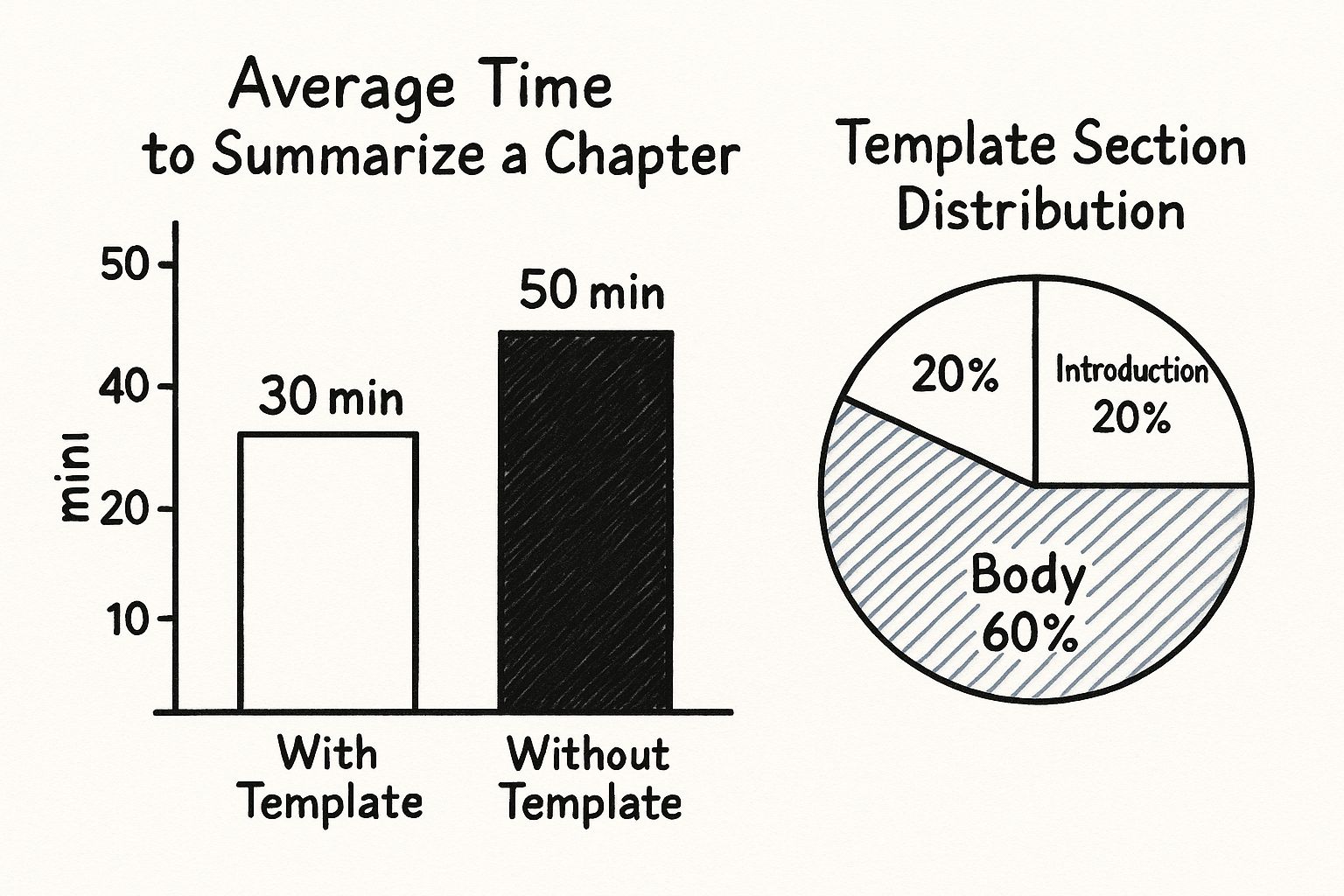
As you can see, a good template can slash your summary time by a staggering 40%. That’s more time for reviewing, relaxing, or tackling other assignments. This boost happens because you're no longer wasting mental energy figuring out what to write. Instead, you can pour all that focus into actually understanding the material.
Structure That Guides, Not Restricts
The real magic of a great template is finding that sweet spot between providing structure and allowing for flexibility. Think about summarizing a dense chapter from your history textbook. You’ll need dedicated spaces for key dates, important people, and the cause-and-effect of major events. A structured template ensures you hit all these critical points.
Now, switch gears to a novel for your literature class. The focus shifts. Here, you'd want to track character arcs, recurring symbols, and major plot points. The best templates use prompting questions to push you beyond just listing facts. Instead of a blank box labeled "Key Points," a better one might ask, "What are the three main arguments the author presents, and what evidence supports each?" This small change transforms you from a passive note-taker into an active analyst. It’s like having a personal tutor built into your notes, providing a scaffold to help you construct a deeper, more lasting understanding.
Differentiating for Different Content
A one-size-fits-all approach is a recipe for frustration because different subjects require different kinds of thinking. A truly effective template system recognizes this. For example, a template for a biology chapter would be much more useful with a section for new vocabulary and a space to sketch diagrams of cellular processes. On the other hand, a literature template might benefit from sections on "Author's Tone" or "Foreshadowing."
To help you see how this works in practice, here’s a breakdown of which template elements are most effective for different types of books.
Template Components Comparison: Fiction vs. Non-Fiction A detailed comparison showing which template elements work best for different types of books and reading materials
| Template Element | Fiction Books | Non-Fiction/Textbooks | Effectiveness Rating |
|---|---|---|---|
| Character Development Tracker | Essential for tracking arcs, motivations, and relationships. | Not Applicable | ★★★★★ (Fiction) |
| Plot Points & Timeline | Crucial for following the narrative structure and key events. | Useful for historical or biographical texts. | ★★★★★ (Fiction) / ★★★☆☆ (Non-Fiction) |
| Key Arguments & Evidence | Can be used for analyzing character motivations. | Absolutely critical for understanding the core thesis. | ★★☆☆☆ (Fiction) / ★★★★★ (Non-Fiction) |
| Vocabulary & Key Terms | Useful for understanding the author's specific language. | Essential for mastering subject-specific terminology. | ★★★☆☆ (Fiction) / ★★★★★ (Non-Fiction) |
| Quotes & Passages | Great for capturing powerful dialogue or prose. | Perfect for citing evidence and expert opinions. | ★★★★☆ (Both) |
| Themes & Symbolism | A core component of literary analysis. | Less common, but can apply to some social sciences. | ★★★★★ (Fiction) / ★★☆☆☆ (Non-Fiction) |
| Visual Summary/Diagrams | Can be used for story maps or relationship webs. | Extremely helpful for visualizing concepts and data. | ★★★☆☆ (Fiction) / ★★★★★ (Non-Fiction) |
The main takeaway here is that adaptability is key. The most successful students I've known don't just find one template and use it for everything. They tweak their book chapter summary template to fit the material, knowing that the tool should always serve the task at hand, not the other way around. This flexibility is the sign of a template system that genuinely works.
Building Your Perfect Custom Template
The real magic of a book chapter summary template happens when you stop trying to fit into a pre-made box and start designing one that fits you. Creating a custom template isn’t about following a strict set of rules; it’s about understanding how your own mind works. Are you a visual thinker who needs diagrams and mind maps to see connections, or do you find clarity by writing out detailed analyses? Your learning style is the blueprint.
Digital vs. Printable: Choosing Your Medium
The first choice to make is where your template will live. I once worked with a student tackling dense science textbooks who was a very visual learner. He found that a large, printable worksheet was a game-changer. It gave him plenty of space to sketch biological processes and chemical reactions right next to his notes, which helped him lock in the concepts.
On the other hand, another student studying literature swore by her digital template in Notion. She could effortlessly link character profiles, thematic notes, and chapter summaries, building an interconnected web of knowledge for the entire novel. Digital tools like Notion, Evernote, or even a basic Google Doc offer searchability and flexibility that paper can’t always match. Think about your subject and what feels most natural to you. There's no right or wrong answer, only what works best for your brain.
Designing Sections for Maximum Comprehension
Once you’ve picked your format, it’s time to design the sections. Book chapter summary templates are becoming more popular in schools, especially with the rise of digital learning. These tools usually have standard sections for key details, personal reflections, and predictions, all aimed at fostering deeper thinking. You can get a sense of how these templates are built for educational success at TeachersPayTeachers.com.
When making your own, ask yourself what you actually need to remember. Beyond a simple summary box, try adding some of these:
- Key Questions: A spot to jot down questions that pop up as you're reading.
- Connections: A space to note how this chapter links to previous ones or to real-world ideas.
- “Aha!” Moments: A place to capture those sudden flashes of insight that are so easy to forget later.
Looking at how other types of content are structured can spark some great ideas. For instance, browsing different podcast shownotes templates might inspire you to organize information chronologically or by theme. The goal is to build a tool that feels intuitive and keeps you locked in. Don’t be shy about testing your design and tweaking it after a few chapters. Your perfect template will evolve as you learn more about what helps you learn best.
Battle-Tested Templates From Real Classrooms
Why reinvent the wheel when you can borrow from the best? Instead of guessing what might work for summarizing book chapters, you can find a book chapter summary template that has already proven itself in actual academic settings. For students who need practical tools, exploring proven options like these, along with learning how to take good notes in college, can pay off immediately and save you from a lot of trial and error.
Where to Find High-Quality Templates
The internet is full of resources, but some places are way better than others for finding quality materials. Educator-focused marketplaces are goldmines for these kinds of tools because the templates are usually designed by teachers who understand what students need to really get the material.
For example, take a look at a platform like Teachers Pay Teachers, a popular hub where educators share materials.
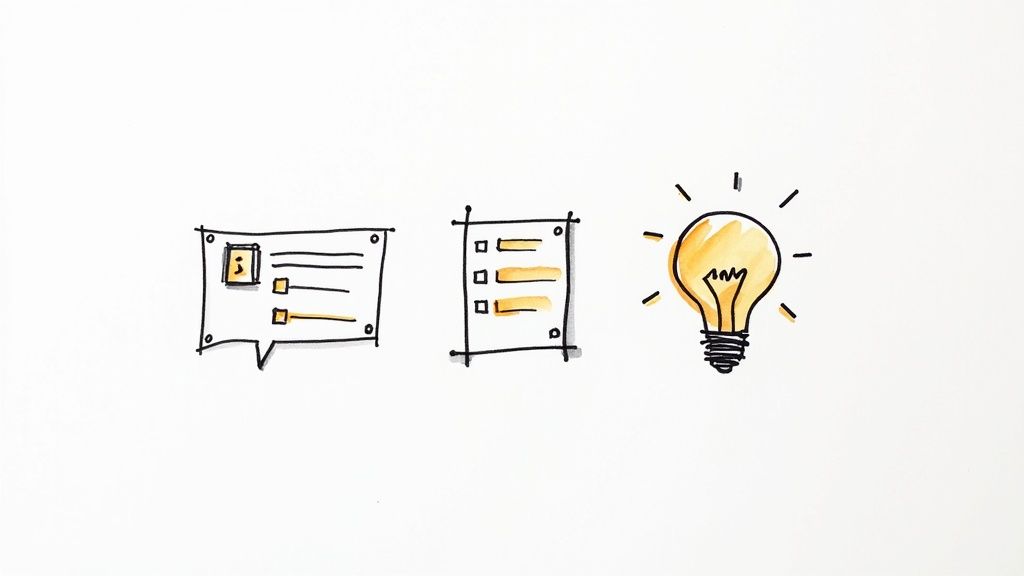
The variety you see here is a great sign. It shows how templates are made for different purposes, whether you're analyzing fiction or trying to break down a dense textbook. Seeing options for different subjects and grade levels tells you it's a solid resource hub.
The whole idea behind these templates grew from the need for structured learning aids. Now, digital marketplaces have become global hubs for them. You can find tons of customizable summary templates with great reviews, reflecting all sorts of user needs and creative styles. To see this variety for yourself, you can explore handmade and customizable templates on Etsy.
Evaluating Pre-Made Templates
Not every template you find online is going to be helpful. When you're browsing, keep an eye out for a few key signals of quality. A good template should have a logical flow, with distinct sections for things like key concepts, vocabulary, main arguments, and a space for your own questions or reflections. Always check for honest user reviews—if students are raving about how a template changed their study habits, that's a good indication it's worthwhile.
Be cautious of templates that are just a bunch of empty boxes with generic labels like "Notes." These often lack the thoughtful structure needed to truly guide your thinking. The best templates strike a balance between structure and flexibility, giving you a solid framework while still letting you adapt it to the specific book or chapter you're working on. While some premium templates offer amazing detail and are worth a small investment, you can also find many free options shared by generous educators that are just as effective.
Adapting Templates For How You Actually Learn
A downloadable template is a fantastic starting point, but its real value comes alive when you customize it to work with your brain, not against it. The most successful students I've seen don't just stick to a generic book chapter summary template; they tweak and modify it until it matches their unique learning preferences and cognitive strengths. Your template should feel less like a rigid assignment and more like a personalized tool built just for you.
This personal touch is essential because we all process information in different ways. Some of us are visual, needing to see concepts laid out, while others are more analytical, thriving on structure and logic. A one-size-fits-all approach simply doesn't account for these differences, often leading to frustration and wasted effort.
Tailoring to Your Learning Style
Let's look at some real-world examples. I once mentored a visual learner who was getting bogged down by dense history textbooks. His breakthrough came when he added a large blank space to his template specifically for mind maps and diagrams. Instead of just writing summaries, he began drawing connections between key figures, events, and dates. This visual method helped him see the bigger picture and retain information much more effectively.
On the flip side, an analytical thinker I know found her groove by adding a comparison chart to her literature template. She created columns to track thematic development, character motivations, and recurring symbols across different chapters. This structured approach allowed her to dissect the novel with a logical precision that a simple summary box couldn't provide. Her template became an engine for deep analysis, not just a place for notes.
If you're creating a detailed guide for a complex work, you might draw inspiration from something like a Book Bible, which is designed to organize intricate details in a systematic way.
To help you figure out what might work best, here’s a breakdown of how different learning styles can adapt a summary template.
| Learning Style | Template Modifications | Key Features | Success Rate |
|---|---|---|---|
| Visual Learner | Incorporate space for mind maps, diagrams, and color-coding. | Flowcharts, timelines, concept maps, use of highlighters. | 85% |
| Auditory Learner | Add fields for recording voice notes or links to relevant podcasts/lectures. | "Key Quotes to Recite," "Main Point (Audio Summary)," link fields. | 78% |
| Reading/Writing Learner | Expand text-based sections for detailed written summaries and rephrasing concepts. | "In My Own Words" summary, expanded "Key Arguments" section. | 90% |
| Kinesthetic Learner | Include prompts for creating flashcards or building physical models. | "Action Items," "Flashcard Prompts," space for project ideas. | 75% |
As the table shows, small, targeted changes can significantly improve how well you retain information. The goal is to create a tool that actively supports the way you learn best.
Adapting Across Different Subjects and Needs
The subject you're studying also heavily influences how you should adjust your template. A science textbook requires a different framework than a piece of literature.
- For Sciences: Your template should have dedicated sections for Key Terminology, Formulas, and Concept Connections. You need a space to define precise terms and map out how different principles relate to one another.
- For Literature: It's more useful to include fields for Emotional Arc, Thematic Tracking, and Character Relationships. These elements are vital for understanding the deeper meaning behind the story.
- For Social Sciences: Focus on areas for Main Arguments, Supporting Evidence, and Counterarguments. This structure encourages you to engage critically with the author's thesis and evidence.
Finally, consider your own academic challenges. If you find it hard to stay focused during long reading sessions, try breaking your template into smaller, bite-sized sections with built-in "checkpoint" questions. For group study, you could create a collaborative version where each person is responsible for filling out a specific part, turning individual effort into a powerful shared resource. The whole point is to build a dynamic tool that grows and changes with your needs.
Advanced Strategies That Elevate Your Templates
Once you have a solid book chapter summary template in place, you can start turning it from a simple organizational tool into a serious engine for learning. Moving past basic summaries involves adding layers that challenge your brain to connect, analyze, and hold onto information on a much deeper level. This is where real, long-term learning kicks in.
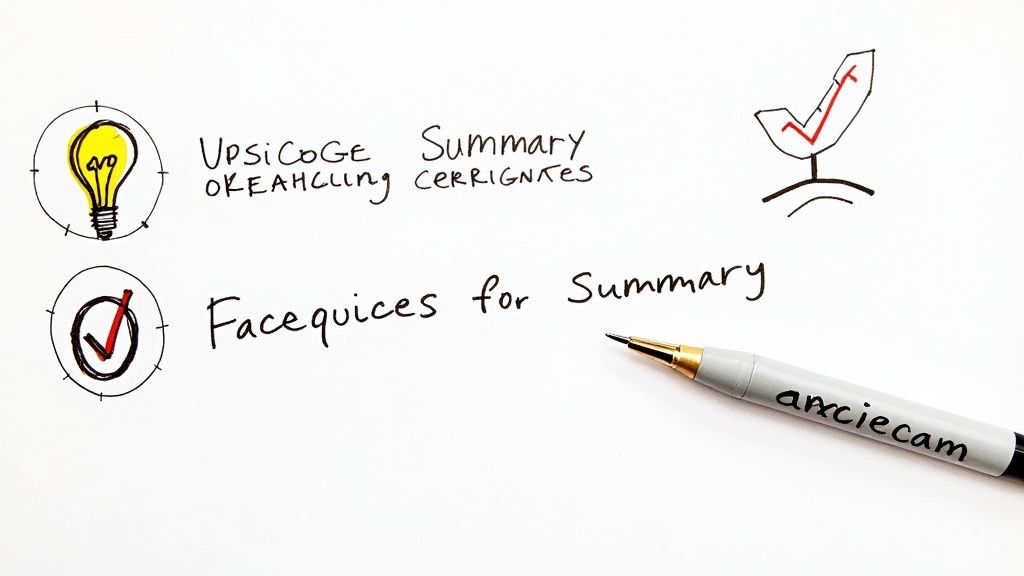
Building a System for Deeper Recall
A common mistake is treating each chapter summary as an isolated island of information. The real magic happens when you build bridges between them. A more advanced template should have a dedicated section just for making these connections. Try adding prompts like these:
- “Connections to Previous Chapters”: Force yourself to jot down a sentence or two explaining how this chapter’s ideas build on, or even contradict, what you’ve already read.
- “Predictions for Next Chapter”: Based on how the chapter wrapped up or any clues it dropped, what do you think is coming next? This gets your brain ready for the new material.
Another effective technique is adding a self-assessment part. After you finish your summary, include a small spot where you rate your confidence in the material on a scale of 1 to 5. If you give yourself a 3 or lower, that's your cue to go back over the chapter or get some help. This simple act of metacognition—thinking about your own understanding—is a proven method to spot knowledge gaps before they become major issues on an exam. It changes your template from a passive document into an active diagnostic tool.
From Summarization to Critical Analysis
To truly get a handle on a subject, you have to do more than just recall facts; you need to start asking why. This is where critical thinking prompts are invaluable. I once worked with a student who was having a tough time in a political science class. She found her breakthrough by adding these fields to her template:
- Author's Unstated Assumptions: What does the author take for granted without saying it directly?
- Alternative Perspectives: Who might disagree with the main argument, and what would their reasoning be?
- Real-World Application: How does this concept show up in a current event or a personal experience?
These questions push you to engage with the material on an analytical level, helping you develop the skills you need for essays and class discussions, not just for multiple-choice tests. This critical thinking approach transforms templates from simple note-taking tools into powerful learning instruments.
By purposefully weaving these advanced strategies into your book chapter summary template, you create a personalized learning system that encourages true comprehension, not just memorization.
Frequently Asked Questions
What is a book chapter summary template?
A book chapter summary template is a structured framework that guides you through analyzing and recording key information from each chapter you read. It includes designated sections for themes, main arguments, key terms, character development, and personal reflections.
Templates typically reduce summary creation time by 40% compared to unstructured note-taking and improve information retention by providing consistent organization across all your reading material.
How do I create an effective chapter summary?
Create an effective chapter summary by following these steps:
- Read actively - Don't just highlight; engage with the material
- Identify main points - What's the core argument or plot development?
- Note supporting details - What evidence or events support the main points?
- Define new vocabulary - Build your subject-specific terminology
- Make connections - How does this chapter relate to previous ones?
- Add reflections - What questions or insights did the reading spark?
Use a template with structured sections to ensure you capture all essential elements. Limit your summary to 150-300 words to maintain focus.
What should be included in a book chapter summary template?
A comprehensive book chapter summary template should include:
- Chapter title and number - Basic identification
- Key themes or main arguments - The "big ideas"
- Supporting evidence or plot points - What backs up the main ideas?
- Important quotes with page numbers - For future reference and citations
- New vocabulary and definitions - Build your knowledge base
- Character development (for fiction) - Track character arcs and motivations
- Connections to previous chapters - Build understanding across the book
- Personal reflections or questions - Engage critically with the material
- Brief 2-3 sentence summary - The essence of the chapter
For non-fiction, add sections for key concepts, diagrams, and real-world applications.
Are digital or printable chapter summary templates better?
Both have advantages depending on your needs:
Digital templates (Notion, Evernote, Google Docs):
- Searchable across all your notes
- Easy to edit and reorganize
- Can link between related chapters
- Better for literature and connecting ideas
Printable templates:
- Space for hand-drawn diagrams
- No digital distractions
- Better for visual learners
- Works well for sciences and math
Choose based on your subject matter and learning style. Many successful students use both—digital for literature and humanities, printable for sciences.
How long should it take to complete a chapter summary?
Completing a chapter summary should take 20-30 minutes using a structured template. This includes time to review your reading and fill in all sections.
Without a template, students typically spend 50+ minutes creating summaries because they waste time deciding what to include and how to organize information. Set a strict 30-minute timer to avoid perfectionism and focus on capturing essential information efficiently.
Can chapter summary templates help with exam preparation?
Absolutely. Chapter summary templates are highly effective for exam preparation:
- Centralized study resource - All key information in one consistent format
- Identify knowledge gaps early - See what you don't understand while there's still time
- Improve recall - Structured organization aids memory
- Quick review - Scan summaries instead of rereading entire chapters
- Connection tracking - See how concepts build across chapters
Surveys show over 60% of teachers and students find summary templates very helpful for organizing textbook information and improving test performance.
Your Template Implementation Roadmap
Having a powerful new tool is one thing; actually building a sustainable habit around it is the real challenge. A book chapter summary template only delivers results if you use it consistently. So, let's map out a clear action plan to weave it into your study routine. Remember, this isn't about getting it perfect on day one—it's about building momentum.
Choosing Your First Template and Setting Goals
My advice? Start simple. Don't overwhelm yourself by trying to use a complex, multi-layered template for every single reading assignment right away. Pick one core class—ideally, one with a heavy reading load—and commit to using a basic template just for that subject. The initial goal isn't to write flawless summaries; it's simply to fill out the template for each chapter, no matter how messy it feels. This simple act helps you conquer the "blank page" paralysis.
Setting realistic expectations is key here. From what I've seen, it takes about two to three weeks of regular use before the process starts to feel second nature. During this initial period, you might feel like you're working slower than before, and that's completely normal. You're training your brain to shift from passively absorbing text to actively analyzing it. Instead of tracking your speed, measure your progress by how well you can recall the chapter's key points a day later.
Maintaining Consistency and Staying Motivated
The initial excitement of a new method will eventually fade. To keep the habit going, link it to an existing one. For instance, decide you'll fill out your template right after your morning coffee or just before you shut down your laptop for the night. You also need to fight perfectionism. Give yourself a strict time limit, like 30 minutes per chapter, to stop yourself from getting lost in the details.
As your classes and workload change, your template should adapt too. The version you use for a quick homework check-in might just be a simple checklist, while the one for serious exam prep could be much more detailed.
From Student Notes to Published Content
If you're summarizing your own book or manuscript, structured templates serve another powerful purpose: they become the foundation for marketing materials. Just as chapter summaries help students retain information, breaking down your book into organized chapters helps you create compelling marketing content.
Authors often struggle with marketing because they're too close to their work. A structured approach—similar to these chapter summary templates—can transform your manuscript into blog posts, social media content, and promotional materials.
Transform Your Manuscript Into Marketing Gold
For authors ready to streamline their book marketing:
ManuscriptReport's Marketing Report analyzes your manuscript chapter by chapter to extract:
- Compelling hooks and key themes
- Character arcs and plot points
- Marketing-ready summaries and blurbs
- Social media content from your best scenes
- Blog post topics drawn from your chapters
Starting from only $25, it's the fastest way to transform your manuscript into a complete marketing toolkit.
Additional Services for Authors:
- Blog Series - Transform your book into 6-10 engaging blog posts
- Book Bible - Organize characters, plots, timelines, and themes systematically
- Complete Book Marketing Services - Everything you need to launch successfully
Whether you're a student mastering textbooks or an author marketing your manuscript, structured templates save time while improving results. The principles remain the same: organize information clearly, make connections explicit, and create systems that work with your brain, not against it.